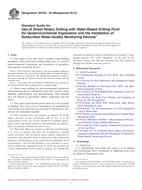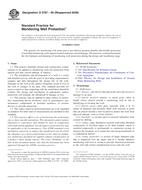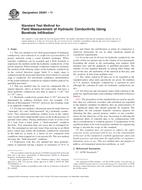Wir benötigen Ihre Einwilligung zur Verwendung der einzelnen Daten, damit Sie unter anderem Informationen zu Ihren Interessen einsehen können. Klicken Sie auf "OK", um Ihre Zustimmung zu erteilen.
ASTM D5782-95(2012)
Standard Guide for Use of Direct Air-Rotary Drilling for Geoenvironmental Exploration and the Installation of Subsurface Water-Quality Monitoring Devices
Automatische name übersetzung:
Standard-Leitfaden für den Einsatz von Direct Air-Drehbohrgerät für Geoenvironmental Exploration und der Installation der Untergrund Wasserqualitätsüberwachungsgeräte
NORM herausgegeben am 15.9.2012
Informationen über die Norm:
Bezeichnung normen: ASTM D5782-95(2012)
Anmerkung: UNGÜLTIG
Ausgabedatum normen: 15.9.2012
SKU: NS-32528
Zahl der Seiten: 7
Gewicht ca.: 21 g (0.05 Pfund)
Land: Amerikanische technische Norm
Kategorie: Technische Normen ASTM
Kategorie - ähnliche Normen:
Die Annotation des Normtextes ASTM D5782-95(2012) :
Keywords:
air-rotary drilling method, drilling, geoenvironmental exploration, groundwater, vadose zone, ICS Number Code 73.100.30 (Equipment for drilling and mine excavation)
Ergänzende Informationen
| Significance and Use | ||||||||||||||||||||||||
|
4.1 The application of direct air-rotary drilling to geoenvironmental exploration may involve sampling, coring, in situ or pore-fluid testing, installation of casing for subsequent drilling activities in unconsolidated or consolidated materials, and for installation of subsurface water-quality monitoring devices in unconsolidated and consolidated materials. Several advantages of using the direct air-rotary drilling method over other methods may include the ability to drill rather rapidly through consolidated materials and, in many instances, not require the introduction of drilling fluids to the borehole. Air-rotary drilling techniques are usually employed to advance drill hole when water-sensitive materials (that is, friable sandstones or collapsible soils) may preclude use of water-based rotary-drilling methods. Some disadvantages to air-rotary drilling may include poor borehole integrity in unconsolidated materials without using casing, and the possible volitization of contaminants and air-borne dust. 4.2 The subsurface water-quality
monitoring devices that are addressed in this guide consist
generally of a screened or porous intake and riser pipe(s) that are
usually installed with a filter pack to enhance the longevity of
the intake unit, and with isolation seals and a low-permeability
backfill to deter the movement of fluids or infiltration of surface
water between hydrologic units penetrated by the borehole (see
Practice D5092). Inasmuch as a piezometer is primarily a device
used for measuring subsurface hydraulic heads, the conversion of a
piezometer to a water-quality monitoring device should be made only
after consideration of the overall quality of the installation to
include the quality of materials that will contact sampled water or
gas.
1.1 This guide covers how direct
(straight) air-rotary drilling procedures may be used for
geoenvironmental exploration and installation of subsurface
water-quality monitoring devices.
1.2 Direct air-rotary drilling for
geoenvironmental exploration will often involve safety planning,
administration, and documentation. This guide does not purport to
specifically address exploration and site safety.
1.3 The values stated in SI units are to be regarded as standard. The values given in parentheses are for information only. 1.4 This standard does not purport to address all of the safety concerns, if any, associated with its use. It is the responsibility of the user of this standard to establish appropriate safety and health practices and determine the applicability of regulatory limitations prior to use. 1.5 This guide offers an organized collection of information or a series of options and does not recommend a specific course of action. This document cannot replace education or experience and should be used in conjunction with professional judgment. Not all aspects of this guide may be applicable in all circumstances. This ASTM standard is not intended to represent or replace the standard of care by which the adequacy of a given professional service must be judged, nor should this document be applied without consideration of a project's many unique aspects. The word “Standard” in the title of this document means only that the document has been approved through the ASTM consensus process. |
||||||||||||||||||||||||
| 2. Referenced Documents | ||||||||||||||||||||||||
|
Ähnliche Normen:
Historisch
1.9.2012
Historisch
1.4.2009
Historisch
1.5.2012
Historisch
1.7.2008
Historisch
1.9.2012
Historisch
1.11.2011
Empfehlungen:
EEviZak – alle Gesetze einschließlich ihrer Evidenz in einer Stelle
Bereitstellung von aktuellen Informationen über legislative Vorschriften in der Sammlung der Gesetze bis zum Jahr 1945.
Aktualisierung 2x pro Monat!
Brauchen Sie mehr Informationen? Sehen Sie sich diese Seite an.



 ASTM D5783-95(2012)..
ASTM D5783-95(2012).. ASTM D5787-95(2009)..
ASTM D5787-95(2009).. ASTM D5850-95(2012)..
ASTM D5850-95(2012).. ASTM D6032-08
ASTM D6032-08 ASTM D6286-12
ASTM D6286-12 ASTM D6391-11
ASTM D6391-11
 Cookies
Cookies
